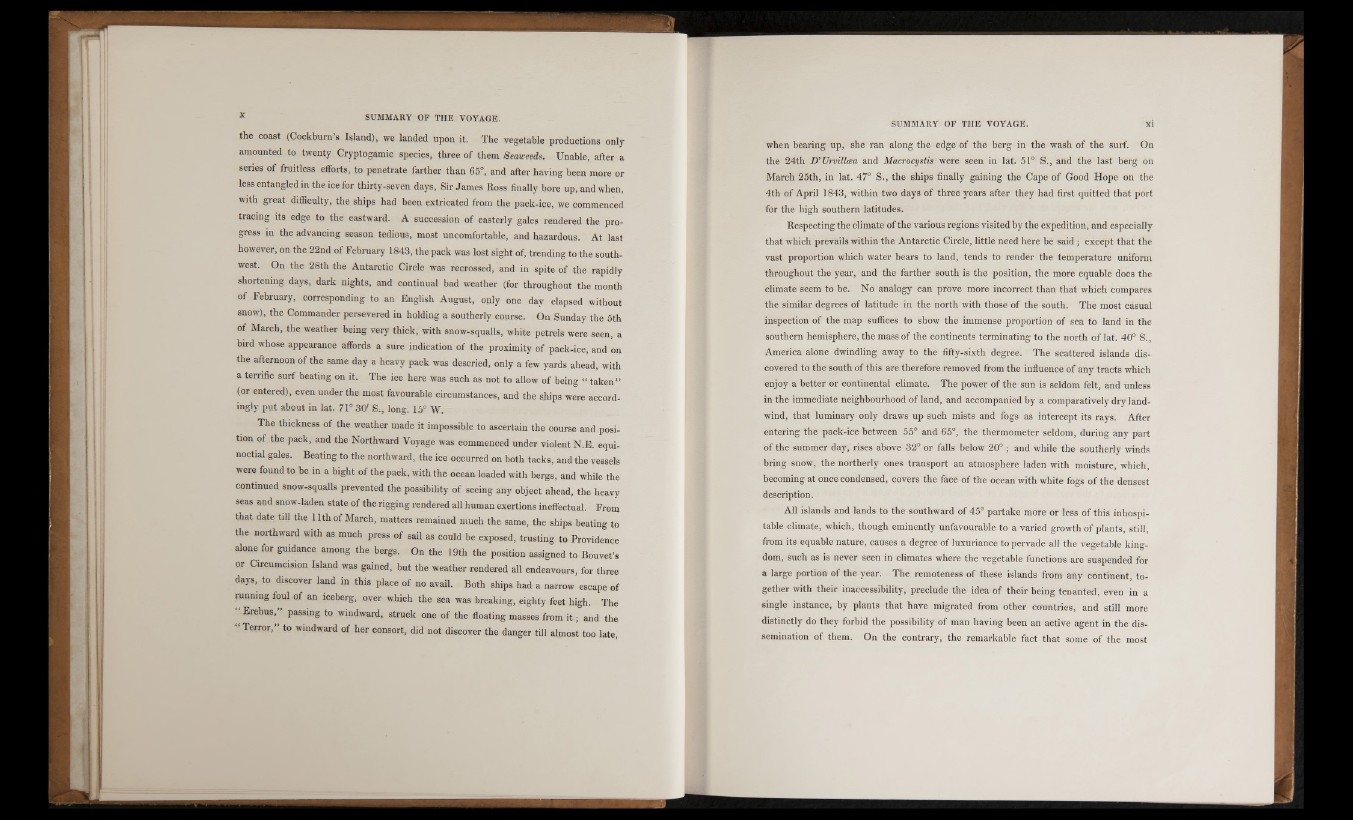
^ SUMMARY OF TH E VOYAGE.
the coast (Cockbura’s Island), we landed upon it. The vegetable productions only
amounted to twenty Cryptogamic species, three of them Seaweeds. Unable, after a
series o f fruitless efforts, to penetrate farther than 65°, and after having been more or
less entangled in the ice for thirty-seven days. Sir James Ross finally bore up, and when,
v ith great difficulty, the ships had been extricated from the pack-ice, we commenced
tracing its edge to the eastward. A succession of easterly gales rendered the progress
in the advancing season tedious, most uncomfortable, and hazardous. At last
however, on the 22nd of February 1843, the pack was lost sight of, trending to the southwest.
On the 28th the Antarctic Circle was recrossed, and in spite of the rapidly
shortening days, dark nights, and continual bad weather (for throughout the month
of February, corresponding to an English August, only one day elapsed without
snow), the Commander persevered in holding a southerly course. On Sunday the 5th
of March, the weather being very thick, with snow-squalls, white petrels were seen, a
bird whose appearance affords a sure indication of the proximity of pack-ice, and on
the afternoon of the same day a heavy pack was descried, only a few yards ahead, with
a terrific surf beating on it. The ice here was such as not to allow of being “ taken”
(or entered), even under the most favourable circumstances, and the ships were accordingly
put about in lat. 71° 30' S., long. 15° W.
The thickness of the weather made it impossible to ascertain the course and position
of the pack, and the Northward Voyage was commenced under violent N.E. equinoctial
gales. Beating to the northward, the ice occurred on both tacks, and the vessels
were found to be in a bight of the pack, with the ocean loaded with bergs, and while the
continued snow-squalls prevented the possibility of seeing any object ahead, the heavy
seas and snow-laden state of the rigging rendered all human exertions ineffectual. From
tnat date till the 11th of March, matters remained much the same, the ships beating to
the northward with as much press o f sail as could be exposed, trusting to Providence
alone for guidance among the bergs. On the 19th the position assigned to Bouvet’s
or Circumcision Island was gained, but the weather rendered all endeavours, for three
days, to discover land in this place o f no avail. Both ships had a narrow escape of
running foul of an iceberg, over which the sea was breaking, eighty feet high. The
“ Erebus.” passing to windward, struck one of the floating masses from it ; and the
“ Terror,” to windward of her consort, did not discover the danger till almost too late.
SUMMARY OF T H E VOYAGE. xi
when bearing up, she ran along the edge of the berg in the wash o f the surf. On
the 24th D ’Urvilleea and Macrocystis were seen in lat. 51° S., and the last berg on
March 25th, in lat. 47° S ., the ships finally gaining the Cape of Good Hope on the
4th of April 1843, within two days o f three years after they had first quitted that port
for the high southern latitudes.
Respecting the climate of the various regions visited by the expedition, and especially
that which prevails within the Antarctic Circle, little need here be said ; except that the
vast proportion which water bears to land, tends to render the temperature uniform
throughout the year, and the farther south is the position, the more equable does the
climate seem to be. N o analogy can prove more incorrect than that which compares
the similar degrees of latitude in the north with those of the south. The most casual
inspection of the map suffices to show the immense proportion of sea to land in the
southern hemisphere, the mass of the continents terminating to the north o f lat. 40° S.,
America alone dwindling away to the fifty-sixth degree. The scattered islands discovered
to the south of this are therefore removed from the influence of any tracts which
enjoy a better or continental climate. The power o f the sun is seldom felt, and unless
in the immediate neighbourhood of land, and accompanied by a comparatively dry land-
wind, that luminary only draws up such mists and fogs as intercept its rays. After
entering the pack-ice between 55° and 65°, the thermometer seldom, during any part
of the summer day, rises above 32° or falls below 20° ; and while the southerly winds
bring snow, the northerly ones transport an atmosphere laden with moisture, which,
becoming at once condensed, covers the face of the ocean with white fogs of the densest
description.
All islands and lands to the southward of 45° partake more or less of this inhospitable
climate, which, though eminently unfavourable to a varied growth of plants, still,
from its equable nature, causes a degree of luxuriance to pervade all the vegetable kingdom,
such as is never seen in climates where the vegetable functions are suspended for
a large portion of the year. The remoteness of these islands from any continent, together
with their inaccessibility, preclude the idea of their being tenanted, even in a
single instance, by plants that have migrated from other countries, and still more
distinctly do they forbid the possibility of man having been an active agent in the dissemination
of them. On the contrary, the remarkable fact that some of the most
Í.